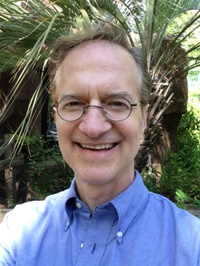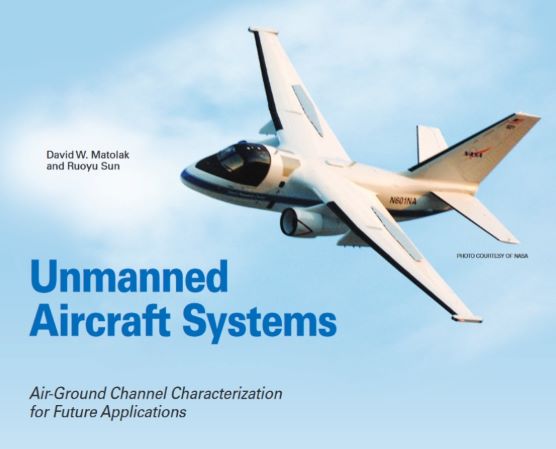Distinguished talk by Prof. David Matolak on - Physical-Layer Reliability for Air-Ground and Air-Air Networking
Reliability schemes for the physical air interface

Vehicle to vehicle and Vehicle to ground communications - reliability aspects and networking.
Physical Layer Reliability Considerations for Air-Ground and Air-Air Networking
A Distinguished Lecture by Professor David Matolak
On a typical day, over 100,000 aircraft take flight across the world. The US Federal Aviation Administration (FAA) predicts over 500,000 registered UAVs (or, “drones”) in 2021, and continued growth is expected. Air traffic management (ATM) is the set of processes and procedures for coordinating all these flights safely and efficiently, and this will become more challenging as air traffic density increases, especially for small and low-flying UAVs. Since effective ATM requires highly reliable communications, researchers across the world are actively investigating new aviation communications for air-ground (AG) and air-air (AA) links, for command and control (C2) as well as for unique UAV applications. In the USA, NASA’s Aeronautics Research Mission Directorate has several programs for integrating new aircraft and UAVs into the National Airspace System, and is now investigating advanced air mobility (AAM), which will include cargo and passenger flights near and within urban areas. Numerous companies, including Uber, Google, Facebook, and Amazon, along with wireless companies such as Qualcomm and Nokia—for 5G and beyond services—are also investigating UAV use. Naturally, traditional aircraft developers such as Boeing and Airbus are also conducting research on UAVs and advanced ATM as well. One 5G service type—ultra-reliable low latency communications (URLLC)—may be of particular interest for advanced air mobility (AAM) and UAV C2 links. In this talk we address high reliability communication for UAVs, focusing primarily on the physical layer. We begin with a short introduction of UAVs, AAM, and AA/AG communications, a few high-profile programs, and a brief description of some UAV communication requirements. From there we address the challenges of a potentially rapidly time-varying and distorting wireless channel that includes multipath components as well as obstructions, and interference, both unintentional and intentional. Included in the presentation are some example AG channel results from a NASA measurement campaign, comments on and results for the modeling of such channels, some recent analytical results for the AA channel, and example results for dynamic statistical channel characteristics such as spatial correlation and statistical stationarity distance. Some remarks on future work for reliable AG/AA networking conclude the presentation.
Date and Time
Location
Hosts
Registration
-
 Add Event to Calendar
Add Event to Calendar
Loading virtual attendance info...
Speakers
 David Matolak of College of Engineering, University of South Carolina
David Matolak of College of Engineering, University of South Carolina
Physical-Layer Reliability for Air-Ground and Air-Air Networking
This talk is by Prof. David Matolak, distinguished speaker of Vehicular Technology Society.
David W. Matolak (S’82, M’83, SM’00, F’21) received the B.S. degree from The Pennsylvania State University, M.S. degree from The University of Massachusetts, and Ph.D. degree from The University of Virginia, all in electrical engineering. He has over 25 years’ experience in communication system research, development, and deployment, with industry, government institutions, and academia, including AT&T Bell Labs, L3 Communication Systems, MITRE, and Lockheed Martin. He has published over 280 papers, multiple book chapters, and has eight patents. Professor Matolak is a Fellow of the IEEE, and is a recipient of multiple awards, including the IEEE Vehicular Technology Society (VTS) Best Propagation Paper award (2017). He has organized many IEEE workshops and special sessions, and has been an Associate Editor for two IEEE journals. He was a professor at Ohio University (1999-2012), and since 2012 has been a professor at the University of South Carolina. His research interests are radio channel modeling and PHY/MAC communication techniques for statistically non-stationary fading channels. Prof. Matolak is also a member of RTCA and ITU standards groups working on aviation communications, and is a member of Eta Kappa Nu, Sigma Xi, Tau Beta Pi, URSI, ASEE, and AIAA.
Biography:
David W. Matolak (S’82, M’83, SM’00, F’21) received the B.S. degree from The Pennsylvania State University, M.S. degree from The University of Massachusetts, and Ph.D. degree from The University of Virginia, all in electrical engineering. He has over 25 years’ experience in communication system research, development, and deployment, with industry, government institutions, and academia, including AT&T Bell Labs, L3 Communication Systems, MITRE, and Lockheed Martin. He has published over 280 papers, multiple book chapters, and has eight patents. Professor Matolak is a Fellow of the IEEE, and is a recipient of multiple awards, including the IEEE Vehicular Technology Society (VTS) Best Propagation Paper award (2017). He has organized many IEEE workshops and special sessions, and has been an Associate Editor for two IEEE journals. He was a professor at Ohio University (1999-2012), and since 2012 has been a professor at the University of South Carolina. His research interests are radio channel modeling and PHY/MAC communication techniques for statistically non-stationary fading channels. Prof. Matolak is also a member of RTCA and ITU standards groups working on aviation communications, and is a member of Eta Kappa Nu, Sigma Xi, Tau Beta Pi, URSI, ASEE, and AIAA.
Research Interests
- Wireless Channel Characterization: statistically non-stationary, multi-band & multi-resolution models; current applications include air-ground channel modeling, vehicle-to-vehicle channel modeling, "micro-channel" modeling for wireless networks on chips.
- Ad Hoc Communication Networks: multiple access, duplexing, & multiplexing schemes for dynamic range/rate/latency/lifetime; performance for non-stationary topologies; ad hoc network metrics
- Modulation/Detection PHY/MAC: Spread Spectrum modulations, efficient detection schemes, & reactive-bandwidth spectral overlay; Narrowband Modulation variable-bandwidth spectral overlay, co-channel interference suppression & rapid performance estimation; robust UAS transmission schemes (e.g., FBMC); V2V channel/MAC modeling
- Random Process Modeling: modeling of communication signals and their statistics
- Electromagnetics Modeling: wave propagation and antennas for communications applications; FDTD & ray tracing
Profile
David Matolak has over 20 years of experience in R&D, design, and deployment of wireless communication systems for terrestrial, satellite, & aeronautical applications. He has worked for AT&T Bell Labs, MITRE, L3 Communications, Lockheed-Martin, & Ohio University, with research funded by NSF, NIST, NASA, DoD, etc. Work focuses on the physical layer of wireless communication systems, and includes modulation/detection, signal processing, radio propagation and channel modeling.
Education
- Ph.D., Electrical Engineering, University of Virginia, Charlottesville, VA, 1995.
- M.S., Electrical and Computer Engineering, University of Massachusetts, Amherst, MA, 1987.
Email:
Address:Swearingen, Room 3A28, 301 Main Street, Columbia, United States, 29208
Agenda
June 10 2021
6.45pm -- host and speaker login, checks
6.55pm -- Introducing the speaker
7.00pm - 8.00 pm Distinguished talk
8.00-8.15pm Q & A

